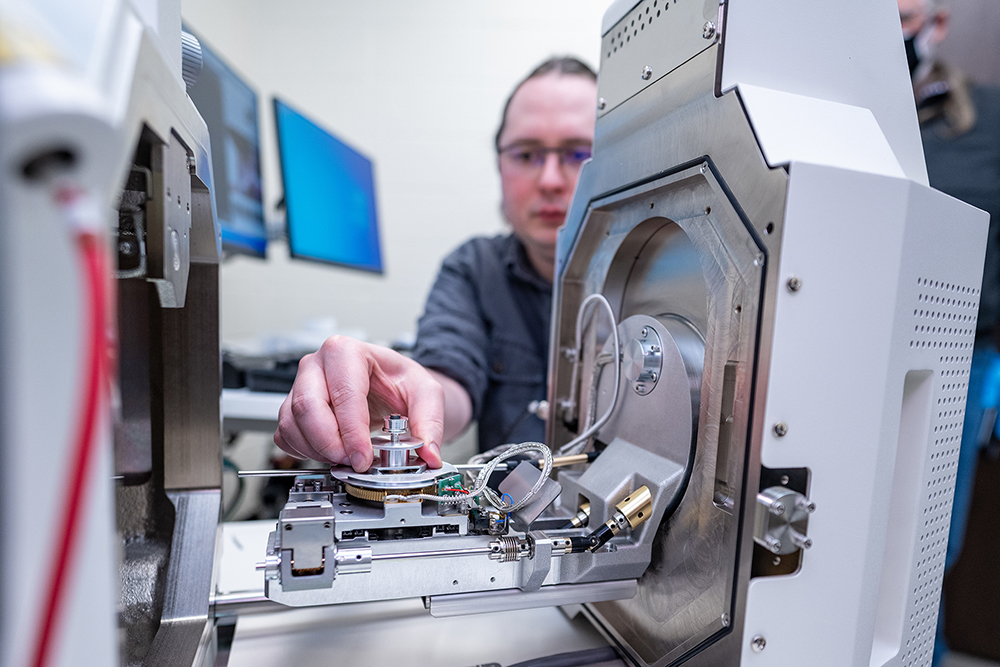
Sam Alvarado, associate professor of inorganic chemistry at UWRF, trains on the university’s new Hitachi scanning electron microscope (SEM) in Centennial Science Hall.
When science students return to the University of Wisconsin-River Falls for spring semester, they will have access to a new instrument with capabilities that will allow them to explore the properties of a specimen sample as never before on campus.
“It’s a real game changer for basically anybody doing science here,” said Samuel Alvarado, associate professor of inorganic chemistry, a member of the faculty team that led the effort to acquire a scanning electron microscope (SEM) for UWRF.
“This is moving us way beyond what we have had on campus in recent memory,” Alvarado said. “What you realize is that the closer you zoom in on a sample, the more you can see. It’s a real Swiss Army knife of technologies.”
A scanning electron microscope shoots a beam of electrons instead of light across the surface of a specimen to form a clear digital image. It can also identify chemical elements in a sample. The microscope has a maximum photographic magnification of 300,000x, with an ability to see features as small as three nanometers in size, Alvarado said.
Funding for the microscope came from the National Science Foundation’s Major Research Instrumentation Program. The instrument has been installed on the second floor of Centennial Science Hall.
Alvarado said the microscope will be used by students in a variety of majors across campus, adding, “It’s an inter-disciplinary piece of equipment.”
Other faculty members who collaborated on the grant proposal were Physics Professor Lowell McCann, Biology Professor Timothy Lyden, and Geology Assistant Professor Kevin Thaisen.
Putting the interdisciplinary group from the College of Arts and Sciences and the College of Agriculture, Food and Environmental Sciences STEM departments together to submit the funding request to the federal government was key to getting the proposal approved, Alvarado said. The first submission was denied, he said, but the group wasn’t deterred.
“We took the feedback (from the grant reviewers) to heart and redid parts of the proposal,” he said. “We had a pretty good feeling about it, but you never know.”
Alvarado said the plan is for the equipment to be ready for spring semester. He is teaching a class that will examine the key parts of the microscope and companion technology and discuss in detail what the SEM can do.
“We will let students get hands-on experience using the instrument,” Alvarado said. “We look at it piece by piece. By the end, we put everything together to use the microscope as a whole tool.”
This type of advanced equipment is being used more frequently in various workplaces, Alvarado said, which is why it is important for UWRF students to have experience on one before they begin their careers.
“In the last few years, the Chemistry Department had two students who have used the SEM in an industry setting,” he said. “Now we can give students training they need on campus as they go out and get employed.”
The specific SEM that UWRF acquired is made by Hitachi High-Technologies.
Chancellor Maria Gallo, who holds a doctorate in genetics, said she is well aware of the value of a scanning electron microscope for students and faculty who are doing research.
“We need to give our students and their professors the best tools we can to explore all that the various sciences have to offer,” Gallo said. “I applaud the deep collaboration among our faculty that brought this tremendous technology to our campus.”
Written by University Communications & Marketing, UW-River Falls
Link to original story: https://www.uwrf.edu/News/UW-River-Falls-acquires-scanning-electron-microscope.cfm
